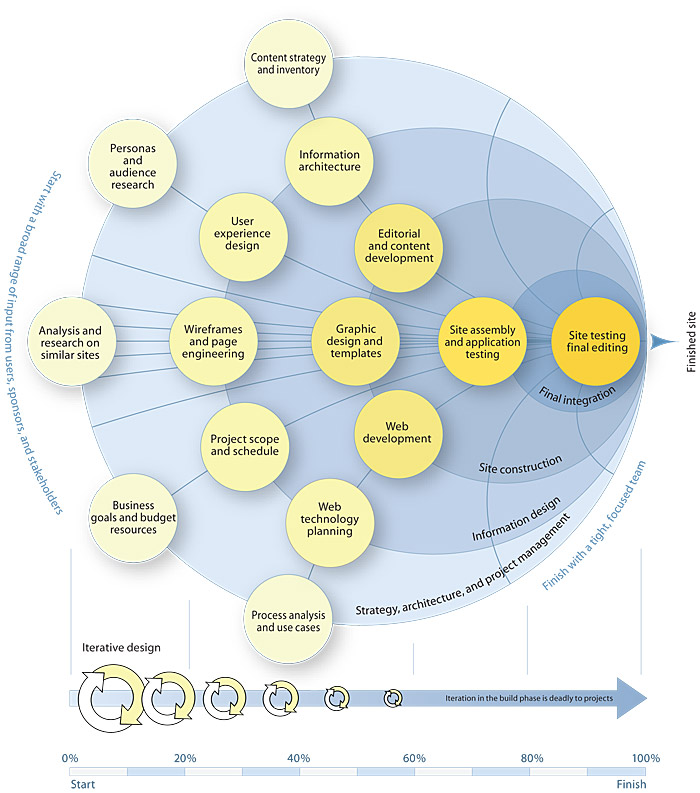What do Rome and Websites have in common? It took Rome approximately 1,009,491 days to build since it was founded in 21st April 753 B.C..
Nothing good comes out from a day of backbreaking work! Great end products are a result of well planned and efficiently executed work. Slow and steady wins the race?
Let’s see why a well planned website development takes time and patience.
REQUIREMENTS AND ESTIMATION
You don’t build a house without an architectural plan. You don’t build a website without a plan either.
Project planning and estimation is the most critical stage of any website development project. To start with, it is crucial to collect all the information from the client that has to potentially convert to concrete information on their websites. Translating business requirements into technical requirements can be challenging, but with patience and thoroughness, we can create clear and understandable requirements.
Projects with poor requirements can expect to spend 49% more money and 39% more time. – IAG Consulting
Requirements Elicitation (Collecting):
It would be ideal if everything was crystal clear after the first meeting and discussion session. But it’s difficult to obtain all the details from your customer after one meeting. It is advisable to have brainstorming sessions, workshops, interviews, questionnaires and prototyping of the product that will lead to a more refined outlook. As soon as this elicitation is complete we move on to analysis and specification.
Requirements analysis
We have to analyze all the information we now have, for specific details, the priority of these requirements and how they are going to impact the project as a whole. We should also consider the feasibility and potentially conflicting issues. Once we do this, we will be able to estimate the time and effort required. The next step is to create a version of the ‘Software Requirements Specification’ used in large IT projects, which could be in the form of wireframes, sketches or user interface prototypes.
Not all clients give the best of explanation of what it is they are actually looking for. These projects are great risk magnets! It becomes very challenging to estimate the time and effort involved. Moreover, there is going to be a number of encounters that is associated with revising the schedule and budget of the website over and over. The complexity involved in a project is hard to estimate in the beginning.
The top two challenges that any of the businesses face are lack of clarity and their requirements not being managed well. [/pullquote] It’s very difficult to work with a ‘I guess I want that’ or ‘maybe that will be good’. The more sure you are the better will be the final result and closer to the desired outcome. And so when a good business analyst persists with questions to bring out clarity, be patient.
Do not rush into anything. The developers who get excited to start the project with very little information or the clients wanting the delivery of the product almost ‘immediately’, serves no purpose at all.
Software Requirements specification
Software requirement specification (SRS) forms the basis of all the further communication with the developer and customers. These requirements have to be clearly understood for the developmental process to go smoothly and efficiently. These specifications must be delivered in a simple and effective way for both the parties to work on. The clarity in the collection of important data directly reduces the re-design processes that might crop up later.
For a website, you would generally not need a detailed SRS document, but a combination of business requirements and wireframes can do the trick.
COLLABORATION AND COMMUNICATION:
Wireframes can be a great communication tool for business owners and developers. It can take the shape of a sketch or a high fidelity design prototype. The visual representation is a great way to simulate and test how the website could look like before spending time on writing code or creating the design.
Wireframes are simple enough that even business owners can document their ideas, vision and requirements by using nothing more than a pen & paper. Requirements and ideas can get lost in words and so a visual approach helps in bringing clarity.
It is pivotal that the client and the team have constant communication. The developer-designer team cannot work in isolation and hope that the end result is exactly what the client needs. At every step of the way, the team must be in contact with the client collecting clarifications and feedback.
For better communication and coordination, it is important to identify responsible point of contacts at both ends. Accountability and clear responsibilities can help prevent delays in communication.
Here are some great tools you can take use for better project collaboration and communication:
Useful tools for collaborative web design work
The 20 best tools for online collaboration
REVISION AND SCHEDULING
Website Development cannot be done at one stretch unless requirements are crystal clear. Even if they are, requirements change, and that adds to extra work for the designer or the developer. Working iteratively from an early sketch, improving on it through a barebones version of the website, till the final website look is achieved, can help tackle most issues.
Endless revisions as a result of scope creep can result in delays and cost overruns. Limiting revisions can be beneficial.
Project Scope Creep – the main reason for website delays. These are the unplanned changes that occur in a project. When the project acquires a life of its own and seems to exponentially grow in the wrong direction, you can be sure that this is a scope creep. This is going to cost you a lot in terms of the budget and the time invested.
It is taxing on the developer if you go on asking for more revisions and changes. Have a contract, an official document stating the number of revisions agreed upon among other things.
Of course! you can review the process as it goes along, but keeping these iterations to the minimal
- saves time
- the project will be focussed on important objectives
- we can avoid complications from over thinking of the project.
No good freelancer or agency works on just one single website at a given point. So while scheduling, he takes into account the other websites he’s working on. If there are delays at either end, it affects the schedule. Most developers accommodate for this in their estimate so it’s impractical of the client to expect websites to be done in 1 day or 1 week.
Set realistic timelines and expectation in the beginning and everyone will be happy.
MIGRATION AND TESTING
A well planned website is first developed in a pre-production environment. Once the iterations and testing are done, it is migrated to a live environment. There are also instances where a website needs to be migrated from its current hosting to a new and upgraded one.
Migration is defined as a large amount of content that is moved from an old URL to a new one, that could be a new domain or sub-domain or maybe merging a small site into a bigger one.
Migration can happen in a day’s time if all goes well, but if issues crop up it can take 3-5 days.
Migration involves a number of complex steps and at each interval there are many issues that come up. Working to migrate a website and fixing these problems can take time.
Testing of websites, today is a lot more complex than ever before. In a mobile world where everyone is browsing on different devices, where tablets are replacing laptops, the complexity of testing websites on different platforms is a challenge. Transition from the desktops and laptops to a more responsive web design, leaves developers testing 15 browsers from their initial number of 6.
A well planned website is a creative and iterative process that requires planning, collaboration, and efficient execution.
I hope we were able to give you an idea of the different aspects that need to be looked into while designing and developing a well planned website. Pick a good developer or agency and trust them with their recommendations. If you find someone who promises a website at a ‘too good to be true’ cost and time, be very skeptical.
Have you had experiences where you’ve had to spend more time than planned on getting your websites developed? Leave your comments and let us know how it turned out.


